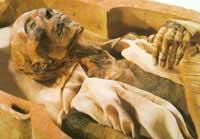Chemistry reveals the secrets of mummies
Archaeologists considered mummifying was nothing more than collecting the corpse with fabric. But the study of Egyptian embalming has shown that mummification was a complex funeral custom.
Researchers Stephen Buckley and Richard Evershed of the University of Bristol have found that the buriers of the pharaohs used abundant oil, fat, fat and wax. Using modern techniques of chemical analysis, these two researchers analyze different mummies of ancient Egypt.

The buriers kept the mummification techniques as a treasure. There is no description written by the Egyptians, and the few data there are are those collected by Greeks and Romans. In addition, mummies, as a historical heritage, are legally protected and the study techniques until now damaged the mummy. But modern chemistry only needs very small samples and, therefore, little harmful to the mummy.
The researchers' conclusions show that in ancient Egypt, as at present, the degree of sophistication of the funeral rite depended on the monetary stock of the deceased's family. Over the years, the themes and techniques used have been modified. Researchers believe that these changes are due to changes in the world's commercial markets and pathways.
XII Egypt 3000 years ago the couple analyzes the mummies of 13 people died from the dynasty until the Roman era. Evidence of various oils used to dry has been found. They were rubbed to protect themselves from moisture and hardened over time.
The researchers have found resin remains of plants appreciated in the mummies. In their day these plants may have a spiritual or cultural meaning, but today scientists know that they are effective antibacterial substances. Therefore, probably these resins would serve to protect the bodies. Bees wax has only appeared in the last mummies. Bees wax is very useful to protect against bacteria.
Buletina
Bidali zure helbide elektronikoa eta jaso asteroko buletina zure sarrera-ontzian











